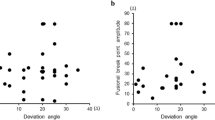Abstract
Background
Treatment for intermittent exotropia X(T) aims to keep the eye in a phoric position and to maintain the phoria. However, maintenance of phoria is difficult even after treatment, and the cause is unclear. The aim of this study was to investigate the presence of suppression during tropia and/or phoria in X(T), and to determine how the suppression affected patient’s ability to maintain phoria.
Methods
Medical records of 89 children with X(T) (mean age, 9.8 ± 2.7 years) were reviewed retrospectively. According to their previous treatment for X(T), the patients were divided into four groups and compared: untreated and under observation only (28 patients), surgical treatment (32 patients), orthoptic training (eight patients) and a combined treatment of surgery and orthoptic training (21 patients). Suppression during phoria was evaluated by a physiologic diplopia test, and suppression during tropia was evaluated by a convergence test or a cover test when fusion broke. Phoria maintenance was achieved if a phoric condition was maintained even when the fusion broke at both near and far. Furthermore, the Bagolini’s red filter bar was used to quantitatively assess patient’s ability to maintain phoria at near and far distances.
Results
No subject only suppressed during phoria. Patients who suppressed under both conditions could not maintain phoria. Suppression under both conditions significantly correlated with phoria maintenance and the ability to maintain phoria (P < 0.01, Fisher’s exact probability test). All the patients with a strong ability to maintain phoria did not suppress under either condition. As compared to the surgical treatment group, the combined treatment group had a higher percentage of patients who did not suppress under either condition and could maintain the phoria. Suppression under both conditions also significantly correlated the treatment methods (P < 0.01, Chi-square for the independence test).
Conclusions
Suppression under both tropic and phoric conditions significantly relates to the outcome of patients’ phoria maintenance and their ability to maintain a phoric position. Suppression under both conditions is an important indication of whether X(T) shifts to constant exotropia.

Similar content being viewed by others
References
Jampolsky A (1954) Differential diagnostic characteristics of intermittent exotropia and true exophoria. Am Orthopt J 4:48–55
Pratt-Johnson J, Wee HS (1969) Suppression associated with exotropia. Can J Ophthalmol 4:136–144
Cooper J, Record CD (1986) Suppression and retinal correspondence in intermittent exotropia. Br J Ophthalmol 70:673–676
Cooper J, Medow N (1993) Major review: intermittent exotropia; basic and divergence excess type. Binocul Vis Eye Muscle Surg Q 8:185–216
Cooper J, Feldman J, Pasner K (2000) Intermittent exotropia: stimulus characteristics affect tests for retinal correspondence and suppression. Binocul Vis Strabismus Q 15:131–140
Serrano-Pedraza I, Manjunath V, Osunkunle O, Clarke MP, Read JC (2011) Visual suppression in intermittent exotropia during binocular alignment. Invest Ophthalmol Vis Sci 52:2352–2364
Pritchard C, Flynn JT (1981) Suppression of physiologic diplopia in intermittent exotropia. Am Orthopt J 31:72–79
Kanaya M, Motoyoshi N, Yoda H, Suzuki H (1991) Suppression of physiological diplopia in intermittent exotropia. Jpn Rev Clin Ophthalmol 85:1940–1946
Melek N, Shokida F, Dominquez D, Zabalo S (1992) Intermittent exotropia: a study of suppression in the binocular visual field in 21 cases. Binocul Vis Strabismus Q 7:25–30
Hardestry HH, Boynton JR, Keenan JP (1978) Treatment of intermittent exotropia. Arch Ophthalmol 96:268–274
Scott WE, Keech R, Mash AJ (1981) The postoperative results and stability of exodeviations. Arch Ophthalmol 99:1814–1818
Kushner BJ (1998) Selective surgery for intermittent exotropia base on distance / near differences. Arch Ophthalmol 116:324–328
Jeoung JW, Lee MJ, Hwang JM (2006) Bilateral lateral rectus recession versus unilateral recess–resect procedure for exotropia with a dominant eye. Am J Ophthalmol 141:683–688
Ekdawi NS, Nusz KJ, Diehl NN, Mohney BG (2009) Postoperative outcomes in children with intermittent exotropia from a population-based cohort. J AAPOS 13:4–7
Pineles SL, Ela-Dalman N, Zvansky AG, Yu F, Rosenbaum AL (2010) Long-term results of the surgical management of intermittent exotropia. J AAPOS 14:298–304
Bagolini B (1957) Presentazione di una sbarra di filtri a densità scalare assorbenti I raggi luminosi; sua utilità nella diagnosi e nella terapia dello strabismo. Boll Ocul 36:638–651
Tanimoto T, Matsumoto F, Ohmure K, Wakayama A, Abe K, Shimomura Y (2001) Evaluation of phoria in patients with intermittent exotropia. Folia Ophthalmol Jpn 52:795–799
Matsumoto F, Ohmure K, Tomiyama S, Tanida K, Tanoue K, Otori T (1997) Orthoptic training to maintain exophoria in cases of intermittent exotropia. Jpn Orthopt J 25:157–163
Matsumoto F (2008) Orthoptic treatment for children with intermittent exotropia—advantages and drawbacks. Jpn Orthopt J 37:71–79
Jampolsky A (1964) Ocular deviations. Int Ophthalmol Clin 4:567–627
Buck D, Powell CJ, Rahi J, Cumberland P, Tiffin P, Taylor R, Sloper J, Davis H, Dawson E, Claeke MP (2012) The improving outcomes in intermittent exotropia study: outcomes at 2 years after diagnosis in an observational cohort. BMC Ophthalmol 12:1. doi:10.1186/1471-2415-12-1
Yildirim C, Mutlu FM, Chen Y, Altinsoy HI (1999) Assessment of central and peripheral fusion and near and distance stereoacuity in intermittent exotropic patients before and after strabismus surgery. Am J Ophthalmol 128:222–230
Acknowledgments
The authors thank Ms. Reiyo Tahara for editorial support.
Conflict of interest
The authors declare that they have no conflict of interest.
The authors have no proprietary interest and received no financial support in the development or marketing of instruments or pieces of equipment mentioned in this article, or any competing instrument or equipment.
Author information
Authors and Affiliations
Corresponding author
Additional information
The authors have full control of all primary data, and agree to allow Graefe’s Archive for Clinical and Experimental Ophthalmology to review the data if requested.
Rights and permissions
About this article
Cite this article
Wakayama, A., Nakada, K., Abe, K. et al. Effect of suppression during tropia and phoria on phoria maintenance in intermittent exotropia. Graefes Arch Clin Exp Ophthalmol 251, 2463–2469 (2013). https://doi.org/10.1007/s00417-013-2410-8
Received:
Revised:
Accepted:
Published:
Issue Date:
DOI: https://doi.org/10.1007/s00417-013-2410-8




